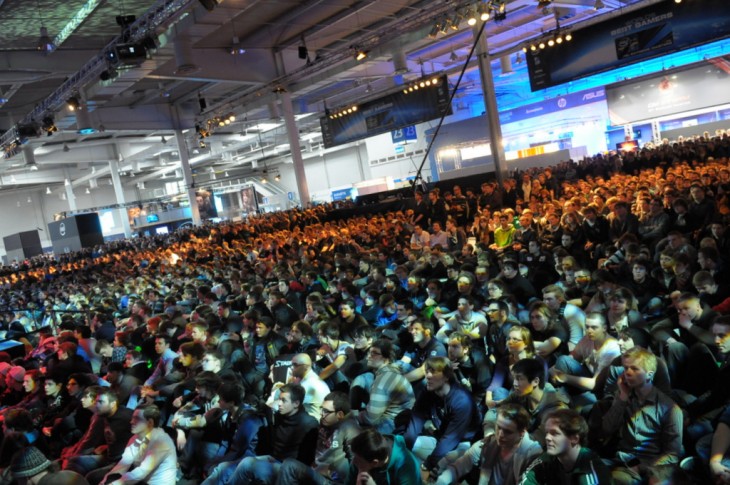Recently I had a chance to visit CeBIT, a long-running technology trade fair and exhibition in Hannover, Germany. The event ran for six days, from Monday the 5th of March to Saturday the 11th; I visited from Thursday to Saturday.
The exhibition grounds are absolutely massive, with hundreds of exhibitors in each titantic hall, and 26 halls in total. There were a lot of cool things being shown off within them, so let’s have a look at a few of the most interesting.

Not quite the real deal.
Dancing Robot – an unusual encounter
One of the most novel experiences at CeBIT was a rather curious humanoid robot.
Its head was a monitor with a cartoon face and a video camera mounted above; it could track your movement and turned and rotated to keep you face to face for the duration of the encounter. As well as recognising and tracking your face, it could also be controlled via a large touchscreen that it held out to you. You could make it look happy or sad (both equally unnerving) or, better, ask it for directions or information about CeBIT.
If you really wanted to feel awkward, you could ask it to dance, choosing from a selection of Korean artists. It would then pull terrible faces and move around the booth, whilst playing the music and showing still images of the original artist – not really a convincing imitation.
Archos 101 G9 Turbo – a solid budget tablet
There were a lot of Android tablets kicking around CeBIT, but the nicest we encountered was this 10.1″ tablet from Archos. It contained a number of innovations on top of a solid spec sheet, yet remained a rather affordable tablet at around £250 compared to offerings from bigger Android vendors like Samsung and Apple’s iPad.
The Archos 101 is a seemingly well constructed tablet, a little thicker than its rivals but feeling all the better for it. The chassis even includes an integrated kickstand, jolly handy if you’re
Inside, you’ll find a dual core A9 processor running at 1.5 GHz, 8 or 16 GB of internal storage plus microSD (with the option of a full 250 GB hard drive as well, although this’ll add considerable bulk to the device).

The Archos G9 Turbo on a certain website.
The display runs at 1280 x 800 resolution, which is standard for mid-range tablets of this size. The user interface felt clean and responsive, with Ice Cream Sandwich running admirably well.
Perhaps the tablet’s most useful feature was its 3G dongle. Instead of being built into the device, the dongle rests in a slot on the rear of the device. You can remove it at any time, and your 3G will move with it – meaning that you can use it for your laptop when you’re on the move. It also means that you don’t have to commit to buying the more expensive model with the 3G dongle included; you can just buy the base model and get the dongle if and when you need it. It also opens up the possibility of using an LTE dongle once LTE reaches the UK.
All in all, definitely a top-notch budget tablet. If you’re looking for a slate and can’t quite afford an iPad, Transformer Prime or Galaxy Tab, then this should definitely be worth a look.
Intel Extreme Masters – the $83,000 StarCraft II tournament

Min Chul holds the trophy aloft, $35,000 richer.
Hall 26 was the gaming hall, and home to one of the biggest e-sports tournaments on the calendar: The IEM StarCraft II World Championships. After five regional tournaments across the world, Hannover was the place where the finals would be held, with 24 players competing for $83,000 in cash prizes.
Of course, these participants aren’t casual players like me; they’re professionals who hone their skills by practising against their team-mates and in leagues worldwide. The strongest players train in Korea, with 12 of the 24 having played there for at least a season, and are favoured to take home the top places in any tournament they enter – particularly bona fide Koreans. Indeed, non-Korean players are known as “foreigners” in the StarCraft II competitive scene.
I arrived in time to see the quarter final matches, where a top-flight Korean called Killer was facing off against a little known Belgian player called Feast. In an incredibly close and tense series, Feast was able to best the Korean 3-2, and book his ticket to the semi-finals. The crowd went wild as he closed out the last game, with thousands cheering for their new foreigner hope.
Although Feast reached the semi-finals, he was defeated 3-1 in a fairly one-sided series by Min Chul, a bombastic player with the nicknames “Boss Toss” and “Obama Toss” (of whom I’m a massive fan). Min Chul would go on to win the championship 3-2, besting fellow Korean Puma in the finals to take home $35,000 and a massive trophy.

A small portion of the crowd at the IEM Finals in Hall 26 at CeBIT
While the top three spots went to Koreans, Feast was brought up on stage for the final award ceremony, where he took home the fan-voted “SICKEST NERD BALLER” award. Thousands of people cheered for the top finishers in the audience and hundreds of thousands watched as the ceremony was streamed online. It was an incredible moment, and a convincingly solid reminder that e-sports is on the rise.
Conclusion
So that’s it then – the three most interesting things I encountered in CeBIT. It’s a massive show with loads on offer, so definitely attend if you have a chance. If you’ve got any questions, then feel free to share ’em with me in the comments below, or hit us up on Facebook or Twitter!